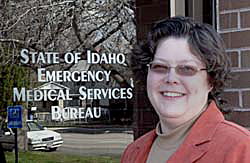
| CONNECTIONS |
IDAHO
ITD
HOME
511 TRAVEL SERVICES
IDAHO
DMV
ITD
NEWS
HIGHWAY
SAFETY
IDAHO STATE POLICE
STATE OF IDAHO
NIATT
NATIONAL
AASHTO
AAMVA
AAA of IDAHO
FEDERAL HIGHWAYS
FEDERAL AVIATION
IDAHO STATE POLICE
NHTSA
NTSB
TRB
U.S. DOT
TRANSPORTER
Archives
Milestones
Comments
Idaho
Transportation
Department
Office of Communications
P.O. Box 7129
Boise, ID 83707
208.334.8005
Fax: 208.334.8563

EMS bureau chief named chairman of national council

Dia Gainor, Emergency Medical Services (EMS) Bureau Chief in the Division of Health, has been appointed to the newly formed U.S. Department of Transportation's National EMS Advisory Council (NEMSAC) and was also chosen to serve as the new Advisory Council's first chairperson.
The Emergency Medical Bureau operates the State Communications Center, which dispatches ITD maintenance crews during off hours and plays a key role in the 511 Traveler Services system.
The advisory council’s inaugural meeting will be in Washington, D.C. on April 24 and 25.
Dia Gainor has served as the state EMS director for Idaho since 1992. While spending 12 years in the field as a firefighter and paramedic, she completed her Bachelor of Science degree in Emergency Health Services Administration at the University of Maryland-Baltimore County and a Master of Public Administration at George Washington University.
 A past president of the National Association of State EMS Officials, Gainor's most recent accomplishments include the appointment to the National EMS Advisory Council, Six Sigma Black Belt certification from the Juran Institute, publication of a chapter in a quality improvement textbook of the National Association of EMS Physicians, and being a founding board member of Advocates for EMS.
A past president of the National Association of State EMS Officials, Gainor's most recent accomplishments include the appointment to the National EMS Advisory Council, Six Sigma Black Belt certification from the Juran Institute, publication of a chapter in a quality improvement textbook of the National Association of EMS Physicians, and being a founding board member of Advocates for EMS.
The National EMS Advisory Council will provide advice and counsel to the Department of Transportation on national emergency medical services initiatives, while offering a forum for the non-federal deliberation of national EMS issues, according to Drew Dawson, Director of the Office of EMS, National Highway Traffic Safety Administration (NHTSA). Since the formation of EMS systems in the 1970s, NHTSA has served as a lead agency for state EMS systems.
A mix of disciplines is represented on the Council, Gainor explains.
"Of all the disciplines that were afforded a seat on NEMSAC, state EMS directors have a unique 'systems' viewpoint that's a real asset when thinking about EMS issues locally or nationally."
Appointment as the chairperson of the new advisory council was an accolade, but not a complete surprise, she said.
"As the Idaho EMS Bureau Chief, I have to work with an incredible diversity of disciplines and special interests, and that composition is no different on the national council."
It took more than a year to select the 25 NEMSAC appointees from a pool of more than 400 nominees. The council is one of two new national EMS advisory groups, one inside and one outside the government. The Federal Interagency Committee on EMS is composed of federal officials, while the National EMS Advisory Council was created to provide input to federal officials engaged in work related to emergency medical services.
"The way I can best contribute is in my capacity as a state EMS director," Gainor says. "I can contribute also by continuing my established history of being a voice for rural and frontier EMS systems, which are often overlooked."
Gainor is a long-standing member and past president of the National Association of State EMS Officials. She has been an active participant in many national level EMS activities and is well known for her expertise in a unique field of quality improvement called "Six Sigma" (a fellowship made possible by Governor Kempthorne and the Western Governors' Association that allowed her to become trained in this program). She has an history of work in other transportation initiatives such as the national Intelligent Transportation Systems Public Safety Advisory Group and Strategic Highway Safety Plan Peer Exchanges.
Gainor's zeal to reduce death and disability from motor vehicle crashes in Idaho has contributed to implementation of a statewide Trauma Registry that will combine records from ambulance services, hospitals, law enforcement crash records and death certificates. This information will help identify opportunities for prevention, system improvement and research, Gainor explains.
Published 4-11-8